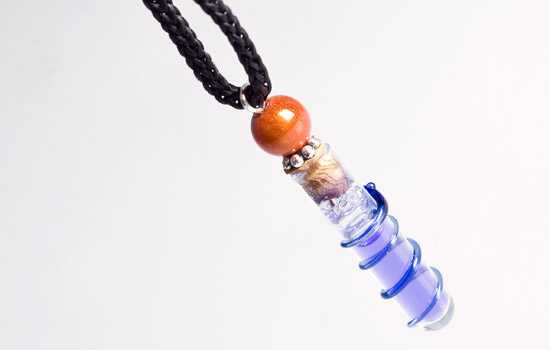DNA necklaces mix science with style...
Popular exhibit has unique appeal
A. Sue Weisler
You've got the look. It's all in your unique DNA necklace.
Are you looking for a piece of jewelry that is totally you?
Then visit the DNA Necklace exhibit in the Thomas Gosnell Hall Atrium and extract some of your own unique double-stranded helix to wear in a decorative vial of your choice.
Last year the exhibitors started the day with 250 glass vials. Word spread and the exhibit was swamped with visitors.
“We ran out early because we didn’t expect it to be that popular,” says Robert Osgood, assistant professor of biomedical sciences at RIT.
This year, Osgood ordered 500 tubes for the festival.
“We still expect to run out early,” he says. “We’re a little bit more organized and we expect to control the flow a little bit better. People can come in on one side, get their product and leave on the other.”
The exhibit grew from an idea Osgood and students from Franklin High School came up with.
They figured that people like jewelry and the notion that something is intrinsically unique. The idea, Osgood says, is that, “nobody else can have one like mine.” And the DNA necklace was born.
The seemingly complex process is surprisingly speedy. Visitors swish a salty water solution—3 percent sodium chloride—in their mouth for about two minutes, using their tongue to gently dislodge cells from the inside of their cheek. The salt solution is returned to the tube and the process really begins. In assembly-line fashion, 35 students, working in two-hour shifts, will add half a milliliter of a 25 percent soap solution to the tubes.
“The soap solution will break open the cells and release the DNA in the solution,” Osgood says. “It’s like a balloon that’s filled with water. If we insert something into the balloon forcefully enough, like a finger, it will rupture that balloon and all the water in the balloon will be released. It’s the same with this procedure in regards to the epithelia cells.”
Next they add 3 milliliters of absolute ethanol. “The ethanol will pull the DNA out of the water phase and into the ethanol phase, and at that point it will precipitate and you can see it—small stringy, sticky looking blobs of intertwined DNA molecules. The original liquid phase remains on the bottom; the ethanol sits on the top and continually pulls the DNA out of the bottom layer.
“As long as the DNA is in a water solution, you can’t see it,” says Osgood. “The ethanol pulls it out of the water phase. And now it’s a solid, it’s not a liquid anymore, and you can see it. And if you can see it, you can pipette some of it off and put it into a little vial.”











